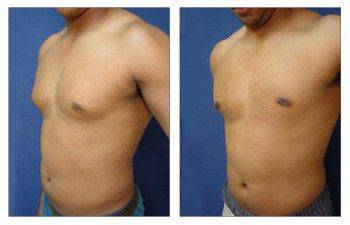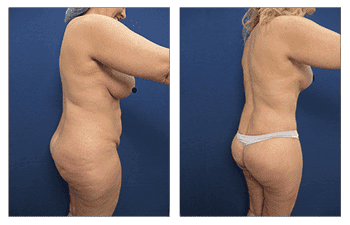
19-year-old male student who underwent bilateral male breast surgery to improve overall breast appearance as he was self-conscious about working out in a tank top – left oblique view

19-year-old male student who underwent bilateral male breast surgery to improve overall breast appearance as he was self-conscious about working out in a tank top – front view

19-year-old male student who underwent bilateral male breast surgery to improve overall breast appearance as he was self-conscious about working out in a tank top – left view

Download SurgiSculpt’s free Liposuction eBook
Gynecomastia Symptoms Introduction
Gynecomastia symptoms can have a wide range spanning from no pain at all to extreme pain or tenderness. However, gynecomastia signs are universal and involve swelling of the breast and chest soft tissues. Gynecomastia symptoms can be sporadic, it is important to explore gynecomastia symptoms unrelated to the breast. In essence, if the overgrowth of either fat or glandular tissues, is compressing a sensory nerve, then pain may be perceived. However, if the growth is minimal to moderate then the tissue may not intrude upon sensory nerves thus making the patient’s case without any symptoms.
When pain is communicated, it is important to rule out any breast tissue atypia or malignancy with an MRI. In contrast, patients who do not have pain may be suffering from poor self-esteem. It is very common for men to avoid social situations where they have to remove their shirts such as swimming pools or the beach.
Younger adolescent males may for example avoid physical education classes in fear of having to expose their chest. Since gynecomastia symptoms can be so sporadic, most decisions regarding surgery are made based on gynecomastia Gynecomastia sign of swelling is observed following either overgrowth of the fat or the mammary glands underneath the nipple and areola complex. Your overall body fat content, i.e. body fat percentage, will most affect the extent of fatty tissues found in the chest and breast. In contrast, the size of the glandular tissues is most affected by your hormone levels which are affected by your testosterone and estrogen levels.
When patients arrive for a consultation, the degree of fat versus glandular tissue is determined in order to customize your gynecomastia surgery. For patients with a propensity for fat over glandular tissues, ultrasound-assisted liposuction can be used to remove the tissues. This is because ultrasound energy may not only break down fatty tissues but also moderate amounts of glandular tissues.
For patients with a very prominent glandular discoid tissue, a direct excision may be required to completely remove the gland. This requires a small incision that is placed under the areola. Most patients do require a combination of regular liposuction as well as direct excision to achieve ideal chest contour outcomes. If you are having gynecomastia symptoms please consider a consultation with SurgiSculpt.
Unpacking Gynecomastia Symptoms and What They Mean
Gynecomastia, a condition often colloquially referred to as “man boobs,” affects many men worldwide. While it’s commonly associated with a visible increase in breast size in males, the symptoms and underlying causes can vary. In this article, we’ll explore the key symptoms of gynecomastia, their implications, and what they signify about the individual’s health and well-being.
The Anatomy of Male Breast Tissue
To understand gynecomastia and its symptoms, it’s crucial to first delve into the anatomy of male breast tissue. Men, like women, have breast tissue, but it’s typically less developed. The balance of hormones, primarily estrogen and testosterone, dictates the growth and maintenance of this tissue. However, when an imbalance occurs, it can lead to gynecomastia.
Hormonal Imbalance and Its Manifestation
Gynecomastia stems from a variety of factors, but the primary culprit is usually a hormonal imbalance. An increase in estrogen levels or a decrease in testosterone can result in male breast tissue growth.
Recognizing the Symptoms of Gynecomastia
Please appreciate this 19-year-old male student who underwent bilateral male breast surgery to improve overall breast appearance as he was self-conscious about working out in a tank top.
Swelling of the Breast Tissue
The most noticeable symptom of gynecomastia is the enlargement of one or both breasts. This swelling can be symmetrical, affecting both breasts equally, or asymmetrical, where one breast appears larger than the other.
Pain or Tenderness
While not always present, some men with gynecomastia may experience pain or tenderness when touching their breasts. This discomfort can range from a mild sensitivity to more pronounced pain.
Nipple Discharge
In more severe cases or instances where an underlying health issue is present, nipple discharge can occur. This symptom is less common but is a clear indicator that a medical evaluation is necessary.
Skin and Areola Changes
For some, the skin around the breast and the areola can undergo changes. It may appear stretched, reddened, or exhibit other discolorations. Additionally, the areola might increase in diameter.
Causes Beyond Hormonal Imbalance
While hormonal shifts are a primary driver, other factors and conditions can lead to gynecomastia symptoms. These include:
Medications and Drugs
Certain drugs, like anti-androgens, anabolic steroids, and even some antibiotics, have been linked to gynecomastia. Additionally, excessive alcohol consumption and the use of illegal substances such as marijuana can contribute to its development. The Mayo Clinic offers a comprehensive list of medications and substances associated with gynecomastia.
Health Conditions
Liver disease, kidney failure, and tumors can lead to hormone imbalances, triggering gynecomastia. Conditions like hyperthyroidism, where the thyroid gland produces too much of the thyroid hormone, can also be a contributing factor.
Aging
As men age, hormonal balances naturally shift, and testosterone levels may decrease, leading to an increase in breast tissue.
Seeking a Diagnosis and Treatment
If you or someone you know exhibits gynecomastia symptoms, it’s essential to consult with a healthcare professional. A physical examination coupled with a detailed medical history can offer insights. Further diagnostic tools like blood tests, mammograms, or MRIs can help pinpoint the exact cause.
While gynecomastia itself isn’t harmful, it can be a sign of an underlying health issue that requires attention. Plus, the emotional and psychological effects shouldn’t be underestimated. For more on treatments, support groups, and personal stories, platforms like RealSelf can provide a wealth of information
Concluding Thoughts on Gynecomastia Symptoms
Gynecomastia symptoms, while often reduced to their aesthetic implications, carry deeper health and wellness connotations. Recognizing its symptoms, understanding its root causes, and seeking appropriate medical guidance are crucial steps in managing and potentially treating this condition.
Please appreciate this 19-year-old male student who underwent bilateral male breast surgery to improve overall breast appearance as he was self-conscious about working out in a tank top.

47-year-old female patient who decided it was worth getting a BBL revision.

47-year-old female patient who decided it was worth getting a BBL revision.

47-year-old female patient who decided it was worth getting a BBL revision.

Download SurgiSculpt’s free Liposuction eBook
Please see this 47-year-old female patient who decided it was worth getting a BBL revision.
